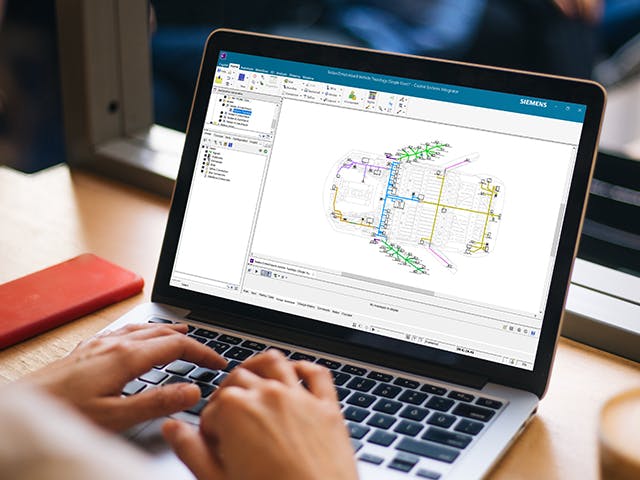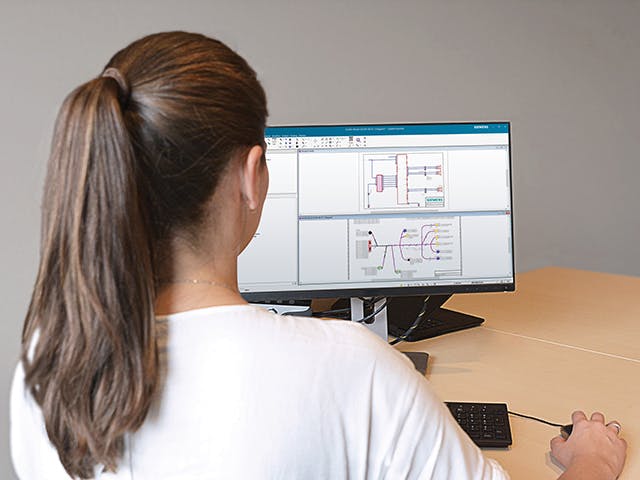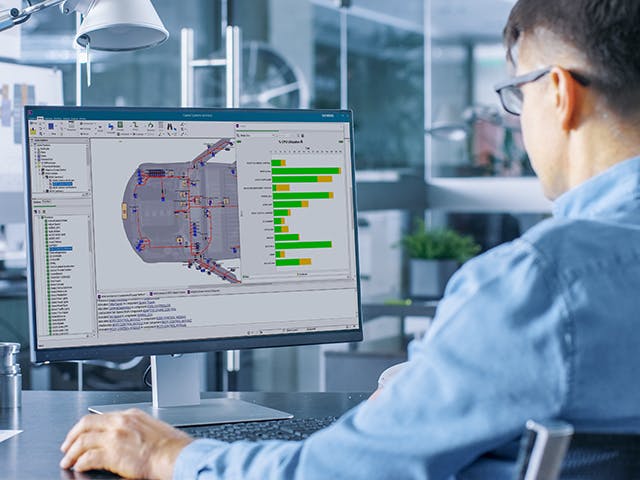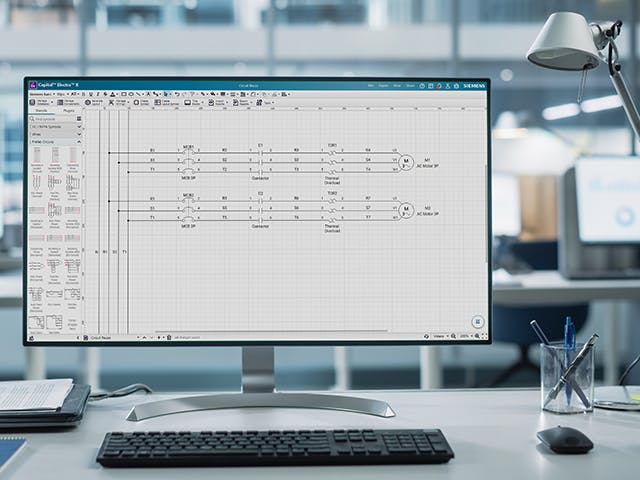
Optimieren Sie die Konstruktion des Elektrosystems
Optimierung und Verifizierung der Elektrik
Ingenieure müssen schnell und unkompliziert fertigungstaugliche Kabelbaumkonstruktionen erstellen können. Führen Sie die Analyse und Verifizierung von Designs innerhalb der Tools mit fortschrittlichen Metriken durch. Verwenden Sie auch die eingebauten Konstruktionsregelprüfungen.
Konstruktion und Simulation elektrischer Systeme
Sie benötigen eine Lösung, die über eine leistungsstarke grafische Bearbeitungsumgebung in Verbindung mit fortgeschrittenen Funktionen zur Konstruktionsverwaltung verfügt. Verwenden Sie Capital, um Schaltpläne zu erstellen, entweder interaktiv oder mit automatischer Diagrammerstellung.
Integration elektrischer Systeme
Beseitigen Sie einen großen Teil der Systemintegrationsaufgaben mit generativer Konstruktion: Ein Durchbruch bei der automatisierten Integration elektrischer Systeme. Sparen Sie Zeit und verbessern Sie die Qualität, damit Sie mehr Zeit für Innovationen haben.
Erstellen und bewerten Sie elektrische Konstruktionen hinsichtlich ihrer Effizienz
Mit den Lösungen von Capital für Systems Engineering der Elektrik können Ingenieure logische und physische Verbindungen in einer gemeinsamen Umgebung erstellen. Erweitern Sie den traditionellen interaktiven Ansatz mit einer integrierten Plattformansicht und verwenden Sie generative Konstruktion, um die Verdrahtungskonfigurationen automatisch zu synthetisieren und zu überprüfen.
Konstruktion und Simulation elektrischer Systeme
Konstrukteure benötigen eine Lösung, die über eine leistungsstarke grafische Bearbeitungsumgebung in Verbindung mit fortgeschrittenen Funktionen für die Konstruktionsverwaltung verfügt. So können Anwender intelligent verbundene logische Systementwürfe (Signale oder Highway-Verbindungen) oder komplette physische Verkabelungssysteme (Drähte, Spleiße, Multicores usw.) erstellen.
Mit Capital ist es möglich, Logik- und Schaltplanentwürfe interaktiv oder mit automatischer Diagrammerstellung zu erstellen. Es wird verwendet, um elektrische Subsysteme zu entwerfen und zu integrieren, beispielsweise die Zusammenführung mehrerer Subsysteme in die physische Struktur. Es wird auch zur Synthese von elektrischen und elektronischen (E/E) Plattformimplementierungen verwendet, um Kosten, Gewicht und Komplexität zu optimieren. Alle Entwürfe werden von branchenführenden Funktionen für die Überprüfung von Konstruktionsregeln, die Analyse von Metriken und die Erstellung von Berichten unterstützt.
Integration und Implementierung elektrische Systeme
Heutige elektrische Systeme sind sowohl hinsichtlich des Produkts als auch der Variationen unglaublich komplex. Um dies zu bewältigen, benötigen Ingenieure hochautomatisierte Lösungen, die ihnen helfen, die Auswirkungen von Konstruktionsentscheidungen zu verstehen, um ihre Entwürfe zu untermauern. Ein wichtiger Ansatz ist die generative Konstruktion, ein Durchbruch bei der automatisierten Integration elektrischer Systeme.
Capital führt die Signalverbindungen der Subsysteme automatisch mit der physischen Topologie zusammen, um eine detaillierte Konstruktion der Fahrzeugverdrahtung zu erstellen. Dadurch entfällt ein großer Teil der Systemintegrationsaufgabe, was Zeit spart, die Qualität verbessert und den Ingenieuren die Freiheit gibt, Innovationen zu entwickeln und eine Vielzahl physikalischer Architekturen zu untersuchen, um das optimale Layout zu ermitteln.
Optimierung und Verifizierung der Elektrik
Ingenieure müssen schnell und unkompliziert detaillierte, geprüfte und fertigungstaugliche Kabelbaumkonstruktionen erstellen können. Bevor die Entwürfe in die Produktionsstätten gelangen, muss sichergestellt werden, dass sie konstruktionsbegleitender Korrekturen unterliegen, um Probleme mit der Qualität und Fertigbarkeit gering zu halten. Fehler der Elektrik haben einen Einfluss auf den Erfolg oder Misserfolg eines Produkts auf dem Markt. Simulation und Analyse spielen eine Schlüsselrolle bei der frühzeitigen Validierung des elektrischen Systems, wo eine Neukonstruktion billiger und einfacher ist.
Unsere Simulations- und Analyselösungen zeichnen sich durch Einfachheit und Benutzerfreundlichkeit aus und bieten jedem Elektrokonstrukteur die Möglichkeit der Verifikation. Capital ermöglicht es Ingenieuren, ihre Entwürfe innerhalb der Tools mit fortgeschrittenen Metriken und einer integrierten Konstruktionsregelprüfung zu analysieren und zu verifizieren. Mit Verifizierungs- und Analysetools können Sie die Korrektheit der Konstruktion bestätigen, bevor die Kabelbäume erstellt werden. Dies ermöglicht eine vollständige Validierung der elektrischen Konstruktion in Verbindung mit einer automatischen Zertifizierung und Berichterstattung.






